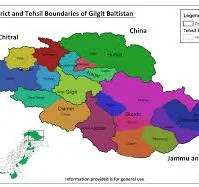Nestled amidst the majestic mountains of the Karakoram Range in Pakistan, Gilgit District stands as a testament to the rich cultural tapestry, breathtaking landscapes, and unparalleled hospitality of its people. From its vibrant cultural heritage to its awe-inspiring tourist attractions and delectable local cuisine, Gilgit District offers an experience like no other. Let's delve into the enchanting world of Gilgit, uncovering its hidden gems and unravelling the essence of this remarkable region.
Cultural Heritage:
Gilgit District is home to a diverse array of cultures, shaped by centuries of history and influenced by various ethnic groups including Shina, Balti, Burusho, and Wakhi. This cultural melting pot is evident in the region's festivals, traditions, and arts. Visitors to Gilgit have the opportunity to immerse themselves in the local way of life, witnessing traditional dances such as the famous 'Attan' and 'Dhamal', or admiring intricate handicrafts like handwoven carpets, embroidered fabrics, and delicate woodwork.
The people of Gilgit take great pride in preserving their cultural heritage, evident in the numerous museums and heritage sites scattered across the district. From the ancient rock carvings of Ganish Village to the historic forts of Baltit and Altit, each site offers a glimpse into the region's storied past, captivating visitors with tales of conquests, trade routes, and dynasties.
Tourist Attractions:
Gilgit District boasts an abundance of natural wonders that leave visitors spellbound. The district serves as a gateway to some of the world's highest peaks, including Nanga Parbat, Rakaposhi, and the mesmerizing Hunza Valley. Adventurers flock to Gilgit for thrilling trekking expeditions, mountaineering challenges, and adrenaline-pumping activities such as white-water rafting and paragliding.
For those seeking tranquility amidst nature, Gilgit offers serene lakes, lush green valleys, and cascading waterfalls. The turquoise waters of Attabad Lake and the emerald beauty of Naltar Valley are just a few of the picturesque destinations waiting to be explored.
Additionally, Gilgit is steeped in religious significance, with ancient Buddhist stupas, shrines, and mosques dotting the landscape. The sacred sites of Kargah Buddha and Rama Meadows are revered by pilgrims and history enthusiasts alike, offering a glimpse into the spiritual heritage of the region.
Cuisine:
No visit to Gilgit District is complete without indulging in its delectable cuisine, which reflects the region's diverse cultural influences. From hearty meat dishes such as 'Sekhwa' and 'Chapshuro' to savory breads like 'Balti Roti' and 'Gyari', each bite is a celebration of flavors and traditions passed down through generations.
Local markets bustle with activity as vendors sell fresh fruits, dried apricots, and aromatic spices, enticing visitors with the sights and smells of Gilgit's culinary delights. And no meal is complete without a steaming cup of 'noon chai', the traditional salted tea beloved by locals and visitors alike.
Demographics and Importance:
Spread across an area of approximately 14,577 square kilometers, Gilgit District is home to a population of over 250,000 residents. The district serves as a vital hub for trade, commerce, and tourism in the Gilgit-Baltistan region, playing a crucial role in the economic development of Pakistan.
Moreover, Gilgit holds strategic importance due to its proximity to major mountain passes and its role as a gateway to China via the Karakoram Highway. The district serves as a vital link in the China-Pakistan Economic Corridor (CPEC), facilitating trade and connectivity between the two countries.
Beyond its economic significance, Gilgit District is a cultural treasure trove, a natural paradise, and a testament to the resilience and spirit of its people. As tourism continues to flourish and infrastructure improves, Gilgit remains a beacon of hope and opportunity, inviting travelers from around the world to discover its wonders and unravel its mysteries.





